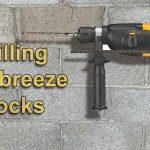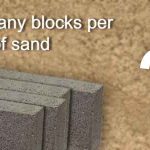There are occasions when you may consider drilling into a lintel. If this is the case, you may be wondering if this is OK, and also the best way to do it.
In this article we will be looking at whether you can drill concrete lintel. As well as the different types of lintels and whether they can be drilled.
We will also look at whether this is a good idea, and if there are any alternative options.

Different types of lintels
Lintels are a structural beam found above openings, such as doors and windows. They can be made from several different materials. These include:
- Wooden Lintels – These are more common in older buildings, although you will still find timber lintels in some modern timber frame construction. These are usually timber combined with steel, to support the outer leaf of masonry.
- Concrete lintel – The use of concrete lintels started in the 1930’s. This type of lintel is made of pre-stressed concrete with reinforced steel running through the lintel. This improves the lintels tensile strength.
Due to their wide use, and lower cost compared with modern steel lintels. Concrete lintels are the most common type of lintel you will come across. - Steel lintels – In more recent years, steel lintels are more common, they are generally much lighter to work with, and compared to concrete, they also have a considerably higher load bearing strength, in relation to their own weight.
- Brick lintels – This is not common in modern properties. However, up to the1950’s, some homes were constructed without lintels. Instead, bricks were fitted on end (soldier course brickwork).
At the time, the opening was often partially supported by the windows. There were usually made from wood or metal and were much sturdier than modern UPVC windows.
Can you drill into concrete lintels
There aren’t many cases where you will need to drill into a lintel. However, you may want too in some instances. For example, if you are fitting curtain rails or some blinds. This will mean you are fitting to the internal side of your lintel.
As we mentioned previously, the most common type of lintel is made of concrete. Drilling a few small holes in to a concrete lintel is not going to cause any issues.
This is especially true for a few small holes. For example, something like an 8mm drill bit, for some red plugs, and small screws shouldn’t be any issue at all.
It wouldn’t be advised to drill lots of large holes all the way through a lintel, as this could weaken it. However, I can’t think of a scenario when this would ever be needed.
So, in most normal situations, such as hanging some blinds or curtains, drilling small holes is not an issue.
The main issue you have, is concrete lintels are tough. So you will need a decent SDS drill and masonry bits. The concrete is far more dense than something like drilling into a breeze block.
One other problem you may face, is hitting the steel reinforcement inside the concrete. If you do this and keep drilling, it will completely destroy the end of a standard masonry SDS bit. However, you can buy specialist SDS bits designed for drilling into reinforced concrete.
You can see some decent SDS bits for this job by clicking here
Drilling into steel lintels
If you need to drill into metal lintels, you will need to use a steel drill bit. This is designed specifically for metal. It can be relatively tough to drill through, and will take a while, but the right bit will do the job.
However, if you are fitting curtains or blinds and you have a standard cavity lintel made from steel. You will not need to drill into any metal.
In this type of lintel, the inner leaf is generally around 100mm wide, and only around 5mm or less in thickness. Brickwork or blockwork is laid on top of this. Therefore, you won’t be fixing into steel. Instead, you will be fixing into the masonry. In this case, you would just use a standard masonry bit.
If the opening is large and some type of RSJ has been used, this will usually have a void behind the plaster. There may also be timber fixed into the steel joist, originally used to fix plasterboard too. This could be a solid piece, or it could be timber soldiers. So you could try and fix into these. Alternatively, if there is a void, you could just opt for a decent drywall fixing.
The only time you would need to drill a steel lintel for something like a curtain rail, would be in solid wall construction, where something like a box lintel has been used.
Alternative ways to fit curtain rails and blinds
In this article I am assuming that most people are drilling lintels to fit curtain rails or blinds. This is certainly the most common reason.
For those who are doing something different, and just wanted to know if you can drill into a lintel. Then hopefully we have answered that question for you already.
For those who are fitting something like curtain rail. This is a good alternative that requires no drilling
The way to do this is to fix a wooden board to the wall, in order to provide a surface to fix too. To do this, I recommend a piece of 150 x 20mm timber or MDF. Either one will do the job.
For a nice finish, you should take the sharp corners off with a plane and then sand. This will give you nice, smooth, rounded corners.
You can use a standard grab adhesive, such as no more nails, to fix the timber to the wall. However, you may need some kind of prop to hold it in place.
Alternatively, if you have access to a 2nd fix nail gun, this is the perfect tool for the job. Simply apply your grab adhesive and pin the board to the wall.
Obviously, nail guns aren’t cheap. However, if you do a lot of DIY, they do come in very handy. A budget option, such as the Ryobi Airstrike nailer, is actually a very good quality tool for the price.
You can read more about this nail gun and see lots of customer reviews by clicking here.
Once your grab adhesive is dry, you can fill any gaps round the edges with a decorator’s caulk, and paint to match the rest of your timber in the room. For white woodwork, this will usually mean a standard gloss.
Conclusion
So there you have it, you can usually drill into lintels without any issues. However, regardless of material, they are generally pretty tough, and this can make the job a little more difficult.
If you are just fitting something like a curtain rail. Then attaching timber to the wall, in order to fix too, is a common and aesthetically pleasing alternative, that requires zero drilling.




